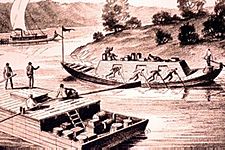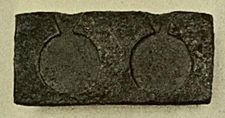Stack Island (Mississippi River) facts for kids
| Geography | |
|---|---|
| Location | Mississippi River, Issaquena County, Mississippi, United States |
| Coordinates | 32°48′N 91°06′W / 32.8°N 91.1°W |
| Length | 6 mi (10 km) |
| Highest elevation | 95 ft (29 m) |
| Administration | |
|
United States
|
|
| State | Mississippi |
| County | Issaquena |
| Demographics | |
| Population | (0) |
Stack Island, also known as Crow's Nest, is an island in the Mississippi River. It is located in Issaquena County, Mississippi, close to Lake Providence, Louisiana. The island is about 200 miles north of New Orleans.
What is Stack Island's History?
Starting in the late 1790s, Stack Island became known as a hiding place for people who broke the law. These included groups who robbed boats on the river and people who made fake money. Some famous outlaws linked to Stack Island were Samuel Mason, Little Harpe, and the father-son team of coin counterfeiters Philip and Peter Alston.
Stack Island was also called "Island No. 94." It was a small island in the middle of a part of the river called "Nine Mile Reach." For many years, it was a meeting spot for people who stole horses, made fake money, and robbed others. From the island, they would go out and stop boats passing by. Sometimes they would attack the boat crews. Other times, they would buy things like horses or flour from the boats.
How Was River Crime Stopped?
In 1809, the main period of river crime on the Upper Mississippi River ended suddenly. A group of flatboatmen decided to attack Stack Island. They wanted to get rid of the people causing trouble there. They attacked at night, and a fight broke out. Some of the boatmen and several of the outlaws were killed.
The attackers captured 19 other men, a 15-year-old boy, and two women. The women and the teenager were allowed to leave. The remaining outlaws faced serious consequences for their actions.
What Happened to Stack Island?
Large floods in 1811 and 1813, along with the 1811–12 New Madrid earthquakes, almost completely washed away Stack Island. Only a low sandbar was left.
Later, from the 1820s to the mid-1830s, a famous Tennessee bandit named John A. Murrell may have operated near Stack Island on the Mississippi River.




